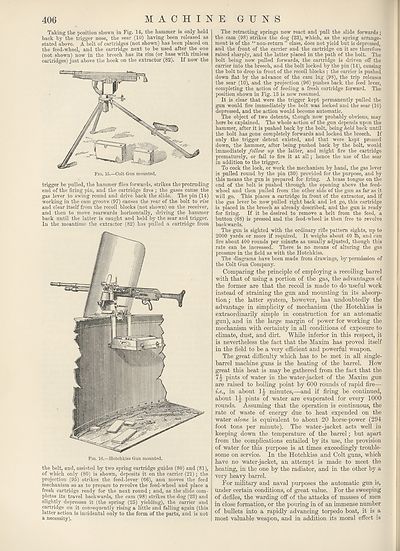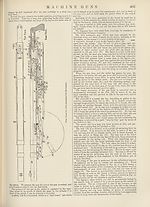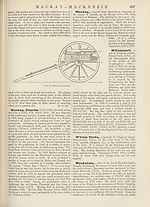New volumes of the Encyclopædia Britannica > Volume 30, K-MOR
(436) Page 406
Download files
Complete book:
Individual page:
Thumbnail gallery: Grid view | List view

MACHINE GUNS
406
Taking the position shown in Fig. 14, the hammer is only held
back by the trigger nose, the sear (10) having been released as
stated above. A belt of cartridges (not shown) has been placed on
the feed-wheel, and the cartridge next to be used after the one
(not shown) now in the breech has its rim (or base with rimless
cartridges) just above the hook on the extractor (82). If now the
trigger be pulled, the hammer flies forwards, strikes the protruding
end of the firing pin, and the cartridge fires ; the gases cause the
gas lever to swing round and drive back the slide. The pin (14)
working in the cam groove (97) causes the rear of the bolt to rise
and clear itself from the recoil blocks (not shown) on the receiver,
and then to move rearwards horizontally, driving the hammer
back until the latter is caught and held by the sear and trigger.
In the meantime the extractor (82) has pulled a cartridge from
Fig. 16.—Hotchkiss Gun mounted.
the belt, and, assisted by two spring cartridge guides (80) and (81),
of which only (80) is shown, deposits it on the carrier (21) ; the
projection (95) strikes the feed-lever (66), ana moves the feed
mechanism so as to prepare to revolve the feed-wheel and place a
fresh cartridge ready for the next round ; and, as the slide com¬
pletes its travel backwards, the cam (98) strikes the dog (23) and
slightly depresses it (the spring (25) yielding), the carrier and
cartridge on it consequently rising a little and falling again (this
latter action is incidental only to the form of the parts, and is not
a necessity).
The retracting springs now react and pull the slide forwards ;
the cam (98) strikes the dog (23), which, as the spring arrange¬
ment is of the “non-return ” class, does not yield but is depressed,
and the front of the carrier and the cartridge on it are therefore
raised sharply, and the latter placed in the path of the bolt. The
bolt being now pulled forwards, the cartridge is driven off the
carrier into the breech, and the bolt locked by the pin (14), causing
the bolt to drop in front of the recoil blocks ; the carrier is pushed
down flat by the advance of the cam lug (98), the trip releases
the sear (10), and the projection (96) pushes back the feed lever,
completing the action of feeding a fresh cartridge forward. The
position shown in Fig. 13 is now resumed.
It is clear that were the trigger kept permanently pulled the
gun would fire immediately the bolt was locked and the sear (10)
depressed, and the action would become automatic.
The object of two detents, though now probably obvious, may
here be explained. The whole action of the gun depends upon the
hammer, after it is pushed back by the bolt, being held back until
the bolt has gone completely forwards and locked the breech. If
only the trigger detent existed, and that were kept pressed
down, the hammer, after being pushed back by the bolt, would
immediately folloio up the latter, and might fire the cartridge
prematurely, or fail to fire it at all; hence the use of the sear
in addition to the trigger.
To cock the lock, or work the mechanism by hand, the gas lever
is pulled round by the pin (30) provided for the purpose, and by
this means the gun is prepared for firing. A brass tongue on the
end of the belt is pushed through the opening above the feed-
wheel and then pulled from the other side of the gun as far as it
will go. This places a cartridge in front of the extractor, and if
the gas lever be now pulled right back and let go, this cartridge
is placed in the breech as already described, and the gun is ready
for firing. If it be desired to remove a belt from the feed, a
button (68) is pressed and the feed-wheel is then free to revolve
backwards.
The gun is sighted with the ordinary rifle pattern sights, up to
2000 yards or more if required. It weighs about 40 lb, and can
fire about 400 rounds per minute as usually adjusted, though this
rate can be increased. There is no means of altering the gas
pressure in the field as with the Hotchkiss.
The diagrams have been made from drawings, by permission of
the Colt Gun Company.
Comparing the principle of employing a recoiling barrel
with that of using a portion of the gas, the advantages of
the former are that the recoil is made to do useful work
instead of straining the gun and mounting in its absorp¬
tion ; the latter system, however, has undoubtedly the
advantage in simplicity of mechanism (the Hotchkiss is
extraordinarily simple in construction for an automatic
gun), and in the large margin of power for working the
mechanism with certainty in all conditions of exposure to
climate, dust, and dirt. While inferior in this respect, it
is nevertheless the fact that the Maxim has proved itself
in the field to be a very efficient and powerful weapon.
The great difficulty which has to be met in all single-
barrel machine guns is the heating of the barrel. How
great this heat is may be gathered from the fact that the
7 h pints of water in the water-jacket of the Maxim gun
are raised to boiling point by 600 rounds of rapid fire—
i.e., in about minutes,—and if firing be continued,
about 1^ pints of water are evaporated for every 1000
rounds. Assuming that the operation is continuous, the
rate of waste of energy due to heat expended on the
water alone is equivalent to about 20 horse-power (294
foot tons per minute). The water-jacket acts well in
keeping down the temperature of the barrel; but apart
from the complications entailed by its use, the provision
of water for this purpose is at times exceedingly trouble¬
some on service. In the Hotchkiss and Colt guns, which
have no water-jacket, an attempt is made to meet the
heating, in the one by the radiator, and in the other by a
very heavy barrel.
For military and naval purposes the automatic gun is,
under certain conditions, of great value. For the sweeping
of defiles, the warding off of the attacks of masses of men
in close formation, or the pouring in of an immense number
of bullets into a rapidly advancing torpedo boat, it is a
most valuable weapon, and in addition its moral effect is
406
Taking the position shown in Fig. 14, the hammer is only held
back by the trigger nose, the sear (10) having been released as
stated above. A belt of cartridges (not shown) has been placed on
the feed-wheel, and the cartridge next to be used after the one
(not shown) now in the breech has its rim (or base with rimless
cartridges) just above the hook on the extractor (82). If now the
trigger be pulled, the hammer flies forwards, strikes the protruding
end of the firing pin, and the cartridge fires ; the gases cause the
gas lever to swing round and drive back the slide. The pin (14)
working in the cam groove (97) causes the rear of the bolt to rise
and clear itself from the recoil blocks (not shown) on the receiver,
and then to move rearwards horizontally, driving the hammer
back until the latter is caught and held by the sear and trigger.
In the meantime the extractor (82) has pulled a cartridge from
Fig. 16.—Hotchkiss Gun mounted.
the belt, and, assisted by two spring cartridge guides (80) and (81),
of which only (80) is shown, deposits it on the carrier (21) ; the
projection (95) strikes the feed-lever (66), ana moves the feed
mechanism so as to prepare to revolve the feed-wheel and place a
fresh cartridge ready for the next round ; and, as the slide com¬
pletes its travel backwards, the cam (98) strikes the dog (23) and
slightly depresses it (the spring (25) yielding), the carrier and
cartridge on it consequently rising a little and falling again (this
latter action is incidental only to the form of the parts, and is not
a necessity).
The retracting springs now react and pull the slide forwards ;
the cam (98) strikes the dog (23), which, as the spring arrange¬
ment is of the “non-return ” class, does not yield but is depressed,
and the front of the carrier and the cartridge on it are therefore
raised sharply, and the latter placed in the path of the bolt. The
bolt being now pulled forwards, the cartridge is driven off the
carrier into the breech, and the bolt locked by the pin (14), causing
the bolt to drop in front of the recoil blocks ; the carrier is pushed
down flat by the advance of the cam lug (98), the trip releases
the sear (10), and the projection (96) pushes back the feed lever,
completing the action of feeding a fresh cartridge forward. The
position shown in Fig. 13 is now resumed.
It is clear that were the trigger kept permanently pulled the
gun would fire immediately the bolt was locked and the sear (10)
depressed, and the action would become automatic.
The object of two detents, though now probably obvious, may
here be explained. The whole action of the gun depends upon the
hammer, after it is pushed back by the bolt, being held back until
the bolt has gone completely forwards and locked the breech. If
only the trigger detent existed, and that were kept pressed
down, the hammer, after being pushed back by the bolt, would
immediately folloio up the latter, and might fire the cartridge
prematurely, or fail to fire it at all; hence the use of the sear
in addition to the trigger.
To cock the lock, or work the mechanism by hand, the gas lever
is pulled round by the pin (30) provided for the purpose, and by
this means the gun is prepared for firing. A brass tongue on the
end of the belt is pushed through the opening above the feed-
wheel and then pulled from the other side of the gun as far as it
will go. This places a cartridge in front of the extractor, and if
the gas lever be now pulled right back and let go, this cartridge
is placed in the breech as already described, and the gun is ready
for firing. If it be desired to remove a belt from the feed, a
button (68) is pressed and the feed-wheel is then free to revolve
backwards.
The gun is sighted with the ordinary rifle pattern sights, up to
2000 yards or more if required. It weighs about 40 lb, and can
fire about 400 rounds per minute as usually adjusted, though this
rate can be increased. There is no means of altering the gas
pressure in the field as with the Hotchkiss.
The diagrams have been made from drawings, by permission of
the Colt Gun Company.
Comparing the principle of employing a recoiling barrel
with that of using a portion of the gas, the advantages of
the former are that the recoil is made to do useful work
instead of straining the gun and mounting in its absorp¬
tion ; the latter system, however, has undoubtedly the
advantage in simplicity of mechanism (the Hotchkiss is
extraordinarily simple in construction for an automatic
gun), and in the large margin of power for working the
mechanism with certainty in all conditions of exposure to
climate, dust, and dirt. While inferior in this respect, it
is nevertheless the fact that the Maxim has proved itself
in the field to be a very efficient and powerful weapon.
The great difficulty which has to be met in all single-
barrel machine guns is the heating of the barrel. How
great this heat is may be gathered from the fact that the
7 h pints of water in the water-jacket of the Maxim gun
are raised to boiling point by 600 rounds of rapid fire—
i.e., in about minutes,—and if firing be continued,
about 1^ pints of water are evaporated for every 1000
rounds. Assuming that the operation is continuous, the
rate of waste of energy due to heat expended on the
water alone is equivalent to about 20 horse-power (294
foot tons per minute). The water-jacket acts well in
keeping down the temperature of the barrel; but apart
from the complications entailed by its use, the provision
of water for this purpose is at times exceedingly trouble¬
some on service. In the Hotchkiss and Colt guns, which
have no water-jacket, an attempt is made to meet the
heating, in the one by the radiator, and in the other by a
very heavy barrel.
For military and naval purposes the automatic gun is,
under certain conditions, of great value. For the sweeping
of defiles, the warding off of the attacks of masses of men
in close formation, or the pouring in of an immense number
of bullets into a rapidly advancing torpedo boat, it is a
most valuable weapon, and in addition its moral effect is
Set display mode to:
![]() Universal Viewer |
Universal Viewer | ![]() Mirador |
Large image | Transcription
Mirador |
Large image | Transcription
Images and transcriptions on this page, including medium image downloads, may be used under the Creative Commons Attribution 4.0 International Licence unless otherwise stated. ![]()
| Encyclopaedia Britannica > New volumes of the Encyclopædia Britannica > Volume 30, K-MOR > (436) Page 406 |
|---|
| Permanent URL | https://digital.nls.uk/193573169 |
|---|
| Attribution and copyright: |
|
|---|---|
| Shelfmark | EB.18 |
|---|---|
| Description | Ten editions of 'Encyclopaedia Britannica', issued from 1768-1903, in 231 volumes. Originally issued in 100 weekly parts (3 volumes) between 1768 and 1771 by publishers: Colin Macfarquhar and Andrew Bell (Edinburgh); editor: William Smellie: engraver: Andrew Bell. Expanded editions in the 19th century featured more volumes and contributions from leading experts in their fields. Managed and published in Edinburgh up to the 9th edition (25 volumes, from 1875-1889); the 10th edition (1902-1903) re-issued the 9th edition, with 11 supplementary volumes. |
|---|---|
| Additional NLS resources: |
|

